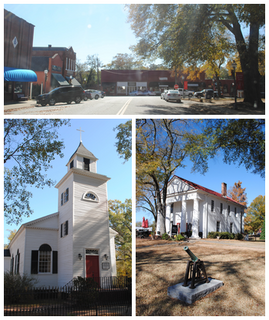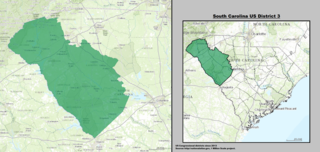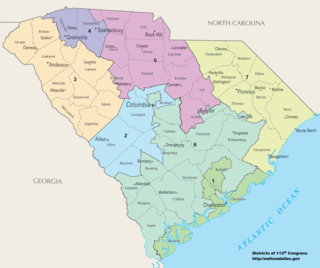
Pendleton District, named after US Judge Henry Pendleton, is a former judicial district in South Carolina. It existed as a county or a district from 7 March 1789 to 20 December 1826.

South Carolina is a state in the Southeastern United States and the easternmost of the Deep South. It is bordered to the north by North Carolina, to the southeast by the Atlantic Ocean, and to the southwest by Georgia across the Savannah River.
In the colonial period, the land around the coast was divided into parishes corresponding to the parishes of the Church of England. There were also several counties that had judicial and electoral functions. As people settled the backcountry, judicial districts and additional counties were formed. This structure continued and grew after the Revolutionary War. In 1800, all counties were renamed as districts. In 1868, the districts were converted back to counties. [1] The South Carolina Department of Archives and History has maps that show the boundaries of counties, districts, and parishes starting in 1682. [2]

The Church of England is the established church of England. The Archbishop of Canterbury is the most senior cleric, although the monarch is the supreme governor. The Church of England is also the mother church of the international Anglican Communion. It traces its history to the Christian church recorded as existing in the Roman province of Britain by the third century, and to the 6th-century Gregorian mission to Kent led by Augustine of Canterbury.

The American Revolutionary War (1775–1783), also known as the American War of Independence, was an 18th-century war between Great Britain and its Thirteen Colonies which declared independence as the United States of America.
Pendleton County was created on 7 March 1789 in the former Indian lands. It included the current Anderson and Pickens counties and all but about 70 square miles (180 km2) along the Chattooga River of Oconee County. The land along the Chattooga belonged the Cherokee and Creek peoples. Pendleton County was attached to Abbeville.

Anderson County is a county located in the U.S. state of South Carolina. As of the 2010 census, its population was 187,126. Its county seat is Anderson. Named for Revolutionary War leader Robert Anderson, the county is located in northwestern South Carolina, along the Georgia border.

Pickens County is a county in the northwest part of the U.S. state of South Carolina. As of the 2010 census, its population was 119,224. Its county seat is Pickens. The county was created in 1826.

The Chattooga River is the main tributary of the Tugaloo River. Its headwaters are located southwest of Cashiers, North Carolina, and it stretches 57 miles (92 km) to where it has its confluence with the Tallulah River within Lake Tugalo, held back by the Tugalo Dam. The Chattooga and the Tallulah combine to make the Tugaloo River starting at the outlet of Lake Tugalo. The Chattooga begins in southern Jackson County, North Carolina, then flows southwestward between northwestern Oconee County, South Carolina, and eastern Rabun County, Georgia. The "Chattooga" spelling was approved by the US Board on Geographic Names in 1897.
On 19 February 1791, Pendleton County became part of the new Washington District, which also included most of Greenville County. On 1 January 1800, Washington District was disbanded. Pendleton County and Greenville County were renamed as districts.
Washington District is a former judicial district in South Carolina. It existed as a district from 19 February 1791 to 1 January 1800. The court house and jail for Washington District were in Pickensville, South Carolina.

Greenville County is a county located in the state of South Carolina, in the United States. As of the 2010 census, the population was 451,225, making it the most populous county in the state. In 2017, the estimated population of the county was 506,837. Its county seat is Greenville. The county is also home to the Greenville County School District, the largest school system in South Carolina. County government is headquartered at Greenville County Square.
On 19 December 1816, Pendleton District gained the Indian lands along the Chattooga. Finally, on 20 December 1826, the Pendleton District was abolished and replaced by Anderson and Pickens Districts. Pickens District incorporated both the current Pickens and Oconee Counties. [3]

Oconee County is the westernmost county in the U.S. state of South Carolina. As of the 2010 census, the population was 74,273. Its county seat is Walhalla.
The court house and jail for Pendleton District were in Pendleton, South Carolina. As the time of the dissolution of the district, its second court house was under construction. This was completed by the Pendleton Farmers' Society. It is still standing in on the Pendleton Square and is part of the Pendleton Historic District. [4]

Pendleton is a town in Anderson County, South Carolina, United States. The population was 2,964 at the 2010 census. It is a sister city of Stornoway in the Outer Hebrides of Scotland.

Pendleton Historic District in Pendleton, South Carolina is a historic district which is located mostly in Anderson County, South Carolina and partly in Pickens County, South Carolina. The district was listed on the National Register of Historic Places in 1970. The historic district includes the town of Pendleton and its immediate surroundings plus a large tract west towards Lake Hartwell to include the Hopewell Keowee Monument and the Treaty Oak Monument. The entire historic district covers an area of over 6,300 acres (25 km2).











